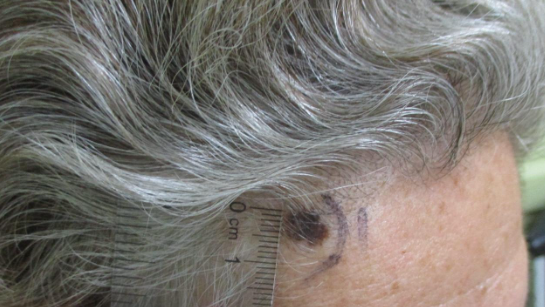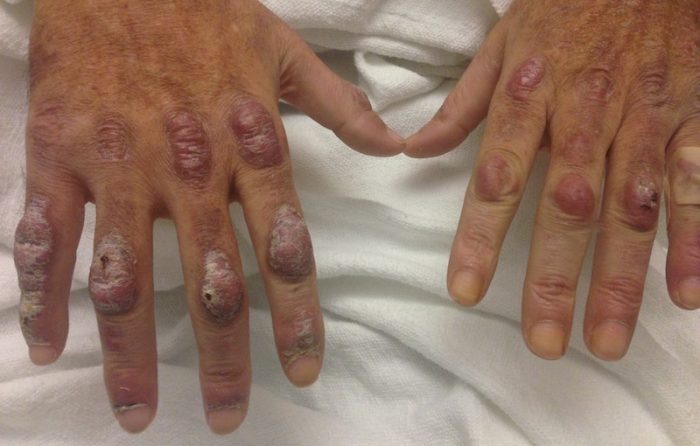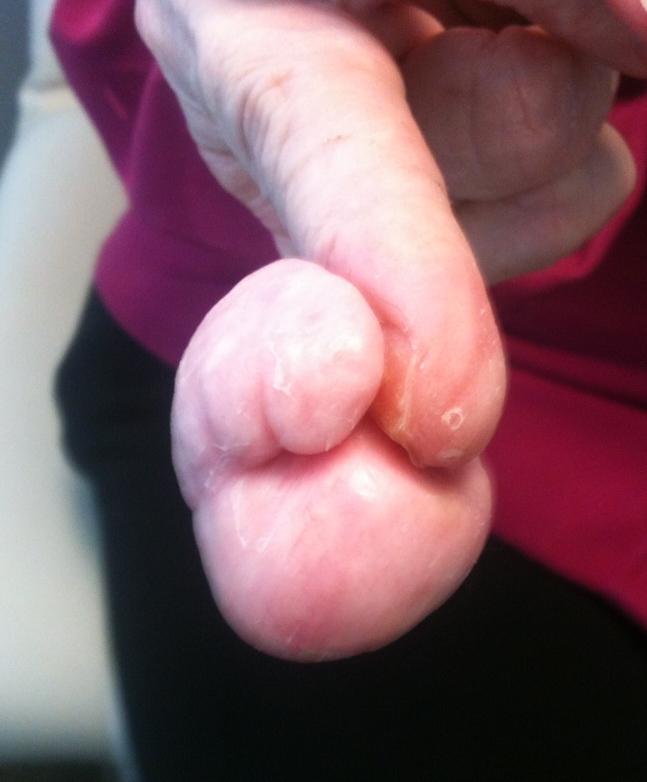CORRECT DIAGNOSIS:
Eosinophilic (pustular) Folliculitis
DISCUSSION:
Dermatologic conditions are often a presenting clue in immunosuppressed patients dealing with the HIV infection. One such condition is eosinophilic (pustular) folliculitis (EPF), a part of the immune restoration syndrome. EPF is a reflection of abnormal Th2/Th1 immune response. This unique culture-negative HIV related disorder often manifests itself late in the disease process when CD4 counts drop below 200 cells/mm3, and maybe the only source of morbidity for the patient (1, 2). Most patients with EPF are men in their third and fourth decade of life (3), and they complain of a chronic, edematous, follicular eruption involving the trunk and face (2). Pustular lesions are uncommon; pustules are usually smaller than in bacterial folliculitis and represent end-stage lesions.
Initial treatment of eosinophilic pustular folliculitis is topical steroids and antihistamines. If the patients fail to respond, phototherapy (UVB or PUVA) or intraconazole 200 mg twice a day may be effective. Some patients repeated applications of permetherin every other night for 6 weeks may be of benefit. This therapy is directed at Demodex mites, which may be the antigenic trigger of this condition.
Isotretinoin is can also be effective often after a few months, in a dose of about .5mg to 1mg/kg/day. Prednisone can be used at an initial dose of 70 mg PO and tapered over two weeks, but lesions frequently reoccur once it is stopped. Other treatment options are dapsone, indomethacin, and tacrolimus which remains to be fully explored and tested.
TREATMENT:
The patient was started on Claritin, Doxycycline 100 mg bid, and Desonide Cream applied bid to decrease inflammation (6). During the course of treatment, other therapies were discussed, but no treatment is considered uniformly effective. The difficulty lies with the pathophysiology of the disease. Some believe EPF is caused by an immune-mediated hypersensitivity to the fungus Malassezia. Our biopsy was negative with PAS stain, but a course of ketoconazole was discussed (7). Multiple bacteria have been blamed, but treatment with antistaphylococcal antibiotics have not been shown to be effective (6).
In the absence of improvement of the underlying immunodeficiency, EPF with HIV infection may be recalcitrant to therapy, and severity can spontaneously fluctuate.
HIV/AIDS continues to be on the rise throughout the world. HIV related dermatosis is being seen at all levels of care, and its unique presentation and treatment should be explored.
REFERENCES:
Ofuji, S., Ogino, A., & Horio, T. (1970). Eosinophilic pustular folliculitis. Acta Dermatologica Kyoto, 50, 195-203. PMID: 5294847
Ofuji, S. (1987). Eosinophilic pustular folliculitis. Dermatologica, 174, 53-56. PMID: 2957313
Ellis, E., & Scheinfeld, N. (2004). Eosinophilic pustular folliculitis: A comprehensive review of treatment options. American Journal of Clinical Dermatology, 208, 229-230. PMID: 15369476
Rosenthal, D., LeBoit, P. E., & Klimpp, L. (1991). Human immunodeficiency virus–associated eosinophilic folliculitis: A unique dermatosis associated with advanced HIV infection. Archives of Dermatology, 127, 206-209. PMID: 1984133
Piantanida, E. W., Turiansky, G. W., & Kenner, J. R. (1998). Immunosuppression-associated eosinophilic folliculitis: Diagnosis by transverse histologic sections. Journal of the American Academy of Dermatology, 197, 178-180. PMID: 9700172
Fearfield, L. A., Rowe, A., Francis, N., et al. (1999). Itchy folliculitis and human immunodeficiency virus infection: Clinicopathological and immunological features, pathogenesis and treatment. British Journal of Dermatology, 141, 3-11. PMID: 10469214
McCalmont, T. H., Altemus, D., Murer, T., et al. (1995). Eosinophilic folliculitis: The histologic spectrum. American Journal of Dermatopathology, 17, 439-446. PMID: 7579502




